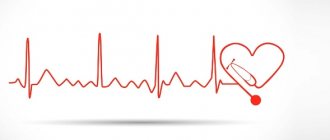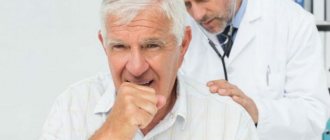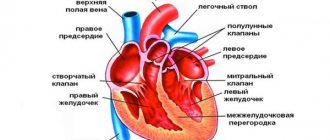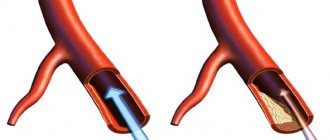Shortness of breath when walking most often occurs in older people. This symptom accompanies many diseases, so doctors at the Yusupov Hospital, before starting treatment for the patient, find out what causes shortness of breath when walking. Patients are examined using the latest diagnostic equipment from leading European and American manufacturers.
During treatment, patients are kept in rooms with a European level of comfort. Doctors individually select the most effective drugs that can affect the cause of shortness of breath in each patient. Rehabilitation specialists develop an individual set of exercises that improve the patient’s well-being. The medical staff is attentive to the wishes of patients and their relatives.
Why does shortness of breath occur when walking?
Severe shortness of breath and palpitations when walking in older people occurs with excessive physical exertion while walking up the stairs or long walks after a sedentary lifestyle. Rehabilitation specialists recommend that older people gradually increase physical activity and rest more often.
Severe shortness of breath when walking in older people occurs with increased emotional stress and excess weight. The cause of shortness of breath may be the following diseases:
- Anemia;
- Heart failure;
- Bronchial asthma;
- Cardiac ischemia;
- Chronic obstructive pulmonary disease.
With anemia, patients complain of dizziness, weakness, increased fatigue, shortness of breath, which increases when walking. Their nails and hair become brittle, cracks appear in the corners of their lips.
In patients suffering from chronic heart failure, the heart cannot fully perform its functions, and the blood does not deliver enough oxygen to the internal organs. A large amount of carbon dioxide accumulates in the body, which stimulates the respiratory center. For this reason, the frequency of respiratory movements and heart contractions increases, shortness of breath appears, which in older people increases when walking.
Bronchial asthma is a disease that rarely begins in old age. Patients experience expiratory shortness of breath, which makes it difficult to exhale. Attacks of suffocation lead to panic, which intensifies suffocation.
The cause of coronary heart disease is insufficient blood supply to the myocardium due to pathology of the coronary arteries. The disease is initially asymptomatic. Over time, angina attacks occur and shortness of breath appears. Older people may develop myocardial infarction.
A common cause of shortness of breath in older people is chronic obstructive pulmonary disease. It develops as a result of frequent respiratory diseases in smokers. Patients are first bothered by a constant cough, then shortness of breath develops, worsening when walking.
Shortness of breath can develop in older people suffering from thyrotoxicosis, diabetes, and obesity. In the first case, the patient's metabolism accelerates, the need for oxygen increases, the frequency of contractions of the heart muscle increases, and hypoxia (lack of oxygen) appears. In patients with diabetes, as the disease progresses, the blood vessels are affected, and oxygen starvation occurs in the body, which causes shortness of breath. Obesity makes it difficult for internal organs to function and leads to shortness of breath in older people. It gets worse when walking.
In patients with pulmonary vasculitis, the vessels suffer, the vessels that supply blood to the lungs suffer. Shortness of breath is one of the first symptoms of the disease, as inflammation interferes with the normal patency of the arteries, which causes oxygen starvation.
When shortness of breath is normal: complex information is accessible
To begin with, it doesn’t hurt to understand primary anatomy if someone has taken a school anatomy course. Despite the fact that breathing seems to us something absolutely natural, simple and understandable, almost all systems of our body are involved in it. Blood, heart vessels, mouth, nasopharynx, bronchi and blood vessels, all of this is somehow involved in breathing.
The mechanism of the respiratory system: how shortness of breath occurs
By expanding the chest, we draw in another portion of air, which passes through the upper and lower respiratory tract, and then only enters the lungs.
There, oxygen is separated and enters the alveoli. It is there that the molecules of the gas we need so much are bound by the essential protein hemoglobin and attached to red blood cells (erythrocytes). Only after this, along with the blood, it spreads throughout the body. In the reverse order, hemoglobin “catches” harmful and toxic substances, and at the same time carbon dioxide, transporting it back to the lungs. As a result, we exhale all this unnecessary waste into the environment. But this is far from a complete cycle, because other organs also do quite serious work. For example, the heart pumps up pressure in the pulmonary circulation. The muscles of the diaphragm allow the lungs to contract and expand, releasing carbon dioxide and taking in air again. Control this complex mechanism that we simply do not notice, the respiratory center in the brain. It is so reliably designed that its operation generally ceases only after almost all other life support systems are turned off.
However, breathing does not always occur involuntarily. You can also control it consciously. The commands we give are sent through the spinal cord to the diaphragm, causing the chest to expand and contract again. When at least one of the elements of this complex “machine” is damaged, various breathing disorders, such as shortness of breath, may occur. The lack of oxygen is immediately felt by the lungs, then the heart and brain. Then the respiratory center gives a signal to increase the frequency of inhalations and exhalations in order to replenish the missing air reserves.
At its core, shortness of breath (dyspnea) is a violation of the frequency or depth of breathing. It would seem that there is nothing terrible, but the body perceives the lack of air very painfully. Moreover, there may be several reasons for a decrease in the level of oxygen in the blood, which most often causes symptoms of shortness of breath, both quite natural and truly dangerous.
Why shortness of breath shouldn't always be scary
After doing the exercises
Shortness of breath during exercise is quite normal. If muscles work actively, then oxygen consumption in them increases. At the same time, they literally “extract” it from the blood, causing breathing problems. Its rate increases significantly and natural shortness of breath may appear.
Emotional experience
If a person gets scared or feels anxious about something, the breathing process may also be disrupted. Any emotional experience is usually accompanied by the release of a portion of adrenaline into the blood. This hormone causes the diaphragm to work more actively, and the lungs to pump air through themselves faster.
Cough, runny nose or other similar problems
Viruses, bacteria and other microorganisms can cause severe coughing attacks. Nasal congestion is also far from conducive to proper normal breathing. As a result, despite our attempts to cough or blow our nose, the tree receives less oxygen than in its normal state. Therefore, the brain gives a signal to breathe even more often, more actively. If you are still moving towards everything, then the situation becomes seriously complicated, and severe shortness of breath may occur.
Anemia
With this disease, the body's absorption of iron, which is necessary for life, is impaired. Further, the logical chain is simple: the amount of hemoglobin also becomes reduced, but it is he who is responsible for transporting oxygen from the lungs to the brain and other organs. If oxygen becomes very low, the body turns on its first defense mechanism - it begins to breathe more often.
Sedentary work
Few people pay attention to how they sit at the table. The majority does not control their posture at all, often resting their chin on their hands, tucking their legs under them, twisting and bending. This may cause some area of the lungs to simply “squeeze”, temporarily losing its functionality. Therefore, under any load, the brain immediately sends a signal to breathe more often. After all, the volume of air received is not enough for him. As a result, office workers who sit incorrectly for years become accustomed to their muscles so much that they no longer want to straighten at all. Then shortness of breath can become an eternal companion, but it cannot be said that it is too pleasant.
Obesity and overweight
If we talk about excess weight, everything immediately becomes extremely clear. The more difficult it is for you to move your muscles, which is very important with large fat deposits, the more oxygen they need. Since physical activity is considered almost the main cause of difficulty breathing, any movement of an obese person causes attacks of shortness of breath.
In addition, excess weight can be not only an external problem, but also a deeply internal one. Visceral fat can accumulate on internal organs. It envelops and also compresses the internal organs. These usually also include the heart and lungs.
Stuffiness, altitude and poor ventilation
Shortness of breath can occur not only for internal reasons, but also for external ones. For example, if there is a lack of oxygen in the environment, you will most likely experience unpleasant symptoms with the slightest activity. Such shortness of breath after physical activity is completely normal in a stuffy room, during the summer heat, high above sea level.
Causes of shortness of breath
However, not everything is as rosy as it might seem. The safe breathing problems we described above should not scare you. But when shortness of breath and sweating appear at the slightest physical exertion, for example, when walking at a leisurely pace, this may indicate serious problems in the body. Under no circumstances should this be ignored.
- High blood pressure.
- Pneumonia (pneumonia).
- Angina pectoris.
- Ruptured thoracic aneurysm.
- Asthma.
- Anaphylactic shock.
- Pneumothorax (mechanical damage to the lung).
- The presence of a foreign object in the respiratory tract.
- Hormonal imbalances, including thyroid dysfunction.
- Diabetes.
- Pulmonary embolism.
Under no circumstances should we ignore such problems. Shortness of breath for no reason may be the only sign of an asymptomatic heart attack. It is important not to miss the moment, to notice it in order to receive the necessary medical care on time.
Types of shortness of breath in older people
Shortness of breath can be acute or chronic. When acute shortness of breath occurs, the patient feels a feeling of tightness in the chest and lack of air. Shortness of breath develops against the background of pneumonia, bronchial asthma, left ventricular failure, and pulmonary hyperventilation. If the patient does not receive immediate medical attention, respiratory arrest may occur. The cause of acute shortness of breath in older people may be pulmonary embolism. The disease develops when a blood clot enters the pulmonary artery from a peripheral vein. Patients experience sharp pain in the chest, severe shortness of breath, and cyanosis of the upper half of the body.
Cardiac dyspnea, which often occurs in older people, is characterized by a chronic course. It is constantly present in the patient, but at first it is not so strong as to cause concern. Breathing is a little constricted, oxygen enters the body in insufficient quantities. When walking or physical activity, the frequency and depth of breathing increase due to the increased consumption of oxygen by the organs.
There are three types of shortness of breath in older people:
- Inspiratory;
- Expiratory;
- Mixed.
With inspiratory dyspnea, inhalation is difficult, with expiratory dyspnea, exhalation is difficult. With mixed shortness of breath, it is difficult for the patient to inhale and exhale. There are the following degrees of severity of shortness of breath:
- Zero – appears only with strong physical exertion;
- First, breathing is impaired when walking, running, or climbing uphill;
- Second, shortness of breath appears at a normal walking pace;
- Third, due to lack of air, a person is forced to constantly stop;
- Fourth, breathing is impaired at rest and with minor physical exertion.
The appearance of shortness of breath
Shortness of breath in any of its manifestations is a specific symptom, which is characterized by certain external signs, namely:
- feeling of acute lack of air, slight suffocation;
- increasing the depth of inhalations and exhalations;
- increased breathing and heart rate.
Everyone is familiar with this, and shortness of breath appears with little or significant physical activity, as the body strives to maintain the required level of oxygen for normal functioning. As a result, respiratory contractions accelerate.
The signal about the lack of oxygen, which passes through the lungs and heart, enters the human brain. The respiratory center is activated, giving the command to accelerate inhalations and exhalations. The less trained a person is, the more often shortness of breath will occur when moving, even slightly. It is not difficult to overcome this condition, but first we will analyze the pathological reasons for which people complain of shortness of breath with minimal physical exertion, for example, when climbing to the second floor.
Evaluation of patients with shortness of breath
At the first stage of examining an elderly patient with suspected chronic shortness of breath, doctors at the Yusupov Hospital determine which organ system is primarily affected: cardiac, pulmonary, both or neither. If the patient continues to suffer from shortness of breath despite intensive therapy, exclude the presence of a concomitant factor - an emotional reaction to the disease or a deterioration in general physical condition. Elderly patients with chronic cardiopulmonary disease may gradually limit physical activity because shortness of breath is associated with exertion, which leads to subsequent imbalance of the cardiovascular system and further worsens shortness of breath with walking or exercise. An analysis of anamnestic data, the results of a physical examination and plain radiography helps to establish an accurate diagnosis.
For chronic shortness of breath, which worsens in older people when walking, doctors perform first-level tests:
- Detailed general blood test;
- Metabolic indicators;
- Plain radiography of the chest organs;
- Electrocardiography;
- Spirometry;
- Pulse oximetry.
Second-level tests include echocardiography, determination of the level of brain natriuretic peptide, pulmonary function testing, Holter monitoring, and radioisotope research methods. If the diagnosis has not been established, after consultation with specialists, at a meeting of the Expert Council, a decision is made on the safety of performing third-level tests on elderly patients: examination of the cardiovascular system during exercise, bronchoscopy, and lung biopsy.
Sources that cause shortness of breath
Many reasons can provoke this phenomenon. Quite common sources of such discomfort are:
- pathologies of the cardiovascular system;
- various allergies;
- obesity;
- lung diseases;
- psychogenic factors (aggression, anger);
- serious blood infections;
- climate change;
- panic attacks;
- hormonal disbalance;
- smoking;
- physiological disorders that prevent air from passing through the nose, mouth or throat.
Very often people do not pay special attention to anxiety symptoms. And he practically doesn’t think about why shortness of breath during physical activity began to occur more often. This phenomenon is attributed to the environment, hard work, and bad habits. Ignoring this problem is completely wrong.
Doctors say that in people who suffer from severe shortness of breath during physical activity, the following pathologies are most often diagnosed during the examination:
- Heart diseases. This is one of the common causes of this phenomenon, especially among older people. The heart muscle is not able to cope with its functions. As a result, the flow of oxygen to the organs is reduced. The brain also suffers from this. Such disturbances lead to increased breathing.
- Diseases of the lungs and bronchi. These are fairly common causes of shortness of breath. The phenomenon is provoked by a narrowing of the bronchi, changes in the lung tissue, as a result of which the required amount of oxygen cannot enter the blood. Under such conditions, the respiratory system begins to work intensively.
- Anemia. The patient has normal oxygen enrichment of the blood due to the proper functioning of the lungs. The heart also copes with its function. It normally pushes oxygen to all organs and tissues. However, there is a lack of hemoglobin and red blood cells (red cells), as a result of which the blood flow does not bring the necessary amount of oxygen to the tissues.
Treatment of patients with shortness of breath
If an elderly patient experiences or worsens shortness of breath when walking, doctors prescribe treatment depending on the cause of the respiratory dysfunction. When treating shortness of breath that occurs or worsens during emotional stress, psychotherapists use an integrated approach using psychotherapeutic, medicinal, and physiotherapeutic techniques and measures.
If elderly people have shortness of breath caused by anemia, therapists provide individually selected therapy. When the hemoglobin level is 109-90 g/l, hematocrit 27-32%, a diet is prescribed, including iron-rich foods, salts, polysaccharide compounds of divalent iron, iron (III)-hydroxide polymaltose complex. If the hemoglobin level is below 90 g/l, the hematocrit is below 27%, a hematologist is consulted, and salt or polysaccharide compounds of divalent iron or iron (III)-hydroxide polymaltose complex are prescribed in a standard dosage. In addition to previous therapy, iron (III)-hydroxide polymaltose complex or iron III dextran is administered intravenously. Patients with severe anemic and circulatory-hypoxic syndromes are given infusions of leukofiltered erythrocyte suspension.
If the cause of severe shortness of breath when walking is heart failure, the following medications are prescribed:
- Angiotensin-converting enzyme inhibitors;
- β-blockers;
- Aldosterone receptor antagonists;
- Diuretics;
- Cardiac glycosides;
- Angiotensin II receptor antagonists.
Patients whose cause of shortness of breath, which worsens when walking, is bronchial asthma, are prescribed drugs that dilate the bronchi by reducing the tone of the smooth muscles of the bronchi, and improve bronchial patency by reducing inflammation of the airway wall.
If you are concerned about severe shortness of breath and palpitations when walking, make an appointment with a therapist online or by calling the contact center. After determining the cause of shortness of breath, the doctor will individually select the most effective drugs to restore respiratory function.
Author
Alexander Vyacheslavovich Averyanov
Pulmonologist, MD, professor
Treatment and prevention of dyspnea during exercise
First of all, you need to learn how to breathe correctly, no matter how strange it may sound.
Through exercise, you can increase your lung capacity, which also helps minimize the occurrence of shortness of breath. All your sports activities should be carried out in a well-ventilated area, use clothing that does not restrict movement and you do not experience problems with your well-being. Now we will introduce you to a set of simple exercises that can help prevent shortness of breath. Start performing each of them in four repetitions, gradually increasing their number to 12. If you feel discomfort while performing any exercise, switch to an easier option.
Exercise No. 1
Take a seated position on a chair with your feet together and your back straight. Hands are located on the knee joints. And the feet are next to each other. Move your hands to your lower ribs and begin to inhale slowly. In this case, the head and shoulder joints should tilt to the side. Returning to the starting position, repeat the movement in the opposite direction.
Exercise No. 2
Lie on your back with your knees bent and your feet flat on the ground. As you exhale, lift your pelvis and hold your breath at the maximum end point of the trajectory. Remain in this position for several seconds. While exhaling slowly, return to the starting position.
As you inhale, pull the knee joint of your left leg towards your chest, and as you exhale, return to the starting position. Then repeat the movement on the second leg, and then on both legs at once. During inhalation, the head and shoulder joints should rise and the chin should touch the chest. The complex ends with walking in a circle, and breathing at this moment should be calm.
If you notice an attack of suffocation, you need to take the following steps:
- Calm and then sit the victim down.
- Loosen your clothes so they don't interfere with your breathing.
- Provide fresh air.
- If the victim has heart problems, give him nitroglycerin or another similar medication.
- If it is an asthma attack, then use the appropriate medication.
If the attack cannot be stopped, call an ambulance. Until the medical team shows up. The patient must be supervised. If shortness of breath bothers you often, then stop smoking, try to avoid stressful situations, and also start playing sports.
Causes of pathology in children
It is very important to pay attention to when and how shortness of breath occurs during physical activity in a child. If such a condition is observed after active outdoor games, and it goes away quickly, there is no reason for concern. But if unpleasant symptoms occur even at rest, you should immediately consult a doctor.
Shortness of breath in children can be a sign of a wide variety of diseases:
- laryngitis;
- heart defects;
- diseases of the respiratory system;
- anemia;
- VSD.
Sometimes unpleasant symptoms signal the development of neonatal respiratory distress syndrome. With this pathology, blood flow in the lungs is disrupted, resulting in the formation of edema. This disease can develop in an infant whose mother suffers from heart disease or diabetes. Such a baby experiences frequent and extremely severe shortness of breath. In this case, the skin turns pale or acquires a bluish tint.
Why might a child (2.5 years old) experience shortness of breath during physical activity? The reasons may lie in anemia. It can be caused by impaired absorption of iron, heredity or poor nutrition.
In addition, shortness of breath can occur in babies even as a result of a common cold. It almost always accompanies diseases such as bronchitis, pneumonia, and laryngitis. As a rule, symptoms disappear on their own after the baby is completely cured of the disease that caused it.
Pulmonary dyspnea
Damage to the respiratory tract causes difficulty in the passage of air. Thus, shortness of breath occurs (even with light exertion). Its appearance is associated with the difficulty of normal penetration of oxygen through the walls of the alveoli into the bloodstream. It should be noted that in almost all pathologies of the bronchi and lungs this symptom is present.
Most often, shortness of breath is caused by the following diseases:
- bronchitis;
- chronic obstructive pulmonary disease;
- pneumonia;
- bronchial asthma;
- tumors.
Traditional medicine
If a person is suffering from shortness of breath when walking, treatment can also be carried out using traditional medicine. In this case, the following recipes will be relevant:
- Infusion. Pour a glass of boiling water over one teaspoon of hawthorn flowers. Next, the ingredients must be simmered for 15 minutes in a water bath and left for 45 minutes in a dark place. The medicine is taken three times a day, one-third of a glass.
- Decoction. 0.5 liters of boiling water should be poured into 100 grams of crushed hawthorn fruits. The medicine is simmered over low heat for half an hour, then cooled and filtered. You need to take the product three times a day, 100 ml after meals.
- Oatmeal. It perfectly helps relieve shortness of breath that occurs while moving. To prepare a medicinal dish, you will need to pour 0.5 cups of oat grains with two liters of milk. Everything is placed in a preheated oven and simmered at low temperature for about an hour and a half. You need to eat one glass of porridge an hour before bedtime. The course of treatment with this method is two weeks.
Which doctor should I contact for shortness of breath?
When a person’s diagnosis is still unknown, it is best to make an appointment with a therapist. After the examination, the doctor will be able to establish a presumptive diagnosis and, if necessary, refer the patient to a specialized specialist.
If shortness of breath is associated with lung pathology, you should consult a pulmonologist; if you have heart disease, consult a cardiologist. Anemia is treated by a hematologist, pathology of the nervous system by a neurologist, diseases of the endocrine glands by an endocrinologist, mental disorders accompanied by shortness of breath by a psychiatrist.
(Visited 7,525 times, 2 visits today)











